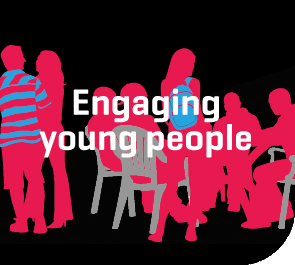
Addressing and involving the younger generation is a way to reach the audience of the future.
To educate young people on contemporary music is the epitome of audience development, and it has become a core task for contemporary music ensembles in a time when no one else teaches young people about this art. They do not hear about it at school or on TV, and you can easily live an entire youth without tripping over contemporary music.
That's why contemporary music ensembles involve themselves in educational projects. They invite school classes to rehearsals and concerts, or give concerts at universities where students can talk with composer, conductor and musicians.
But engaging the younger generation is not just a question of education – giving lectures are often not the way to make anybody interested in anything. What’s needed is also for the music to meet the young people where they are.
The youth culture is almost incompatible with the ritualized world that characterize classical music in general, and perhaps what’s needed is to "invent some new and more appropriate, modern rituals", as one of the ensembles in NewAud said. The ensemble chose to work with a focus group of young people from the city to develop a concert form in line with the everyday and preferences of the 20-25 year olds.
NewAud aimed at helping the participating ensembles to collaborate on the issue that all art forms are asking themselves these days: How do we make young people interested in our art – so that we have an audience in the future?
Other Working Communities
Resources
-
NewAud Evaluation Report
The final report sums up the outcome of the NewAud project. It evaluates the results regarding audience development, the cooperation of the ensembles, as well as the ensembles' artistic development throughout the project.
-
Young People and Learning
This document contains the presentation slides from a talk by arts consultant Heather Maitland on young people and learning.
-
Marketing to Young People
This document contains the presentation slides from a talk by arts consultant Heather Maitland on marketing to young people.
-
How Do Young People Engage WIth Music?
This document contains the presentation slides from a talk by arts consultant Heather Maitland on how young people engage with music.
-
Programming For 15 to 18 Year Olds
The ensembles in the NewAud working community 'Children meet music' met for a workshop discussing what kind of programme might appeal to 15 to 18 year olds. This document lists their recommendations for what to focus on when programming and presenting new music to the young audience.
-
Reaching Out to 19 to 35 Year Olds
The ensembles in the NewAud working community 'Young Audiences' met for a workshop discussing how to market their work to 19 to 35 year olds without alienating existing audiences. This document lists their recommendations regarding venue, concert format, communication and use of social media.
-
Three Ensembles, Two Sounds, One Concert
The Federation of Three Wallonian Ensembles is a working relationship between the three Bruxelles based ensembles Sturm und Klang, Ensemble21 and Ensemble ON. They collaborated during the NewAud project, and held a concert celebrating the final conference in Warsaw. The concert mixed an acoustic and electrified string orchestra with electronic devices, and attracted a big young audience. This document in brief describes the concert.
-
Music and Machines
St Christopher Chamber Orchestra wanted to create a link between music and technology, and therefore engaged young students from the Vilnius Technical University as collaborators in a unique concert. The concert was held in the turbine hall at the Museum of Energy and Technology. The ensemble composed short pieces for the students to play, with the technical instruments, old machines and turbines as musical instruments. This concert report describes the process and outcome of the project.
-
Reopening a Long Lost Concert Hall
Sinfonietta Rīga held a concert marking the reopening of an old concert hall, hidden from the public for more than 30 years. The concert hall is located at the Latvian Academy of Science, and the concert engaged young scientists in the project. With the multidisciplinary nature of the concert, and the venue being a Soviet era heritage, Sinfonietta Rīga's ambition was to attract a broad variety of audience groups: Academics, urban explorers and cultural heritage enthusiasts. This report describes the project and its results, pointing to the great promotional effect for the ensemble.
-
New Music for Music Students
Polish Orkiestra Muzyki Nowej host their own annual New Music Festival. The opening concert was aimed at young people, aged 13-19, attending music schools. To be as close to their target audience as possible, the concert was held at the Szymanowski Secondary Music School. This document in brief describes the concert.
-
The Concert Hall vs. Alternative Venues
The Hebrides Ensemble held two concerts aiming to take their work beyond the major venues, comparing the audience's experience at a concert hall and at an alternative venue. The ensemble held a third concert marking the start of a new collaboration with young musicians from the National Youth Orchestras of Scotland. They made an extensive audience survey at the three concerts. The survey indicates that when programming new music as part of a concert, the ensemble should make sure that the whole experience matches the concert. It also shows that including modern work in classical programmes can help redefine the perception of what your ensemble represents amongst audiences. This evaluation report shows the findings of the survey.
-
Avanti! Playing Classical Music With Children
The Finnish ensemble Avanti! Chamber Orchestra played a unique concert with no less than 60 children on stage – all playing the clarinet. Celebrating their cooperation with the Helsinki Conservatory, the ensemble wanted to engage young children in the world of new music – not only as an audience, but as contributing participants in a professional concert. This document in brief describes the concept of the concert.
